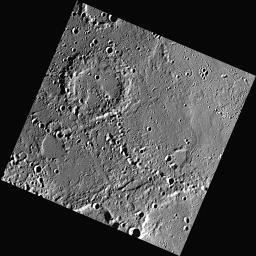The upper right portion of this image shows an area of smooth plains, while chains of secondary craters can be identified cutting across the middle of the image. This portion of Mercury's surface is located about 300 kilometers east of Verdi.
This image was acquired as part of MDIS's high-resolution surface morphology base map. The surface morphology base map will cover more than 90% of Mercury's surface with an average resolution of 250 meters/pixel (0.16 miles/pixel or 820 feet/pixel). Images acquired for the surface morphology base map typically have off-vertical Sun angles (i.e., high incidence angles) and visible shadows so as to reveal clearly the topographic form of geologic features.
On March 17, 2011 (March 18, 2011, UTC), MESSENGER became the first spacecraft ever to orbit the planet Mercury. The mission is currently in its commissioning phase, during which spacecraft and instrument performance are verified through a series of specially designed checkout activities. In the course of the one-year primary mission, the spacecraft's seven scientific instruments and radio science investigation will unravel the history and evolution of the Solar System's innermost planet. Visit the Why Mercury? section of this website to learn more about the science questions that the MESSENGER mission has set out to answer.
Date acquired: April 29, 2011
Image Mission Elapsed Time (MET): 212590162
Image ID: 192040
Instrument: Wide Angle Camera (WAC) of the Mercury Dual Imaging System (MDIS)
WAC filter: 7 (748 nanometers)
Center Latitude: 63.66°
Center Longitude: 204.6° E
Resolution: 163 meters/pixel
Scale: The crater that occupies the upper left portion of the image is about 55 kilometers in diameter
Incidence Angle: 78.8°
Emission Angle: 0.8°
Phase Angle: 79.6°
These images are from MESSENGER, a NASA Discovery mission to conduct the first orbital study of the innermost planet, Mercury. For information regarding the use of images, see the MESSENGER image use policy.

 Planetary Data System
Planetary Data System












